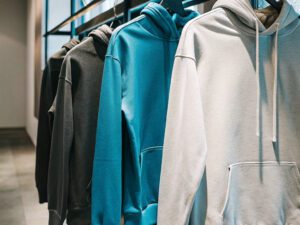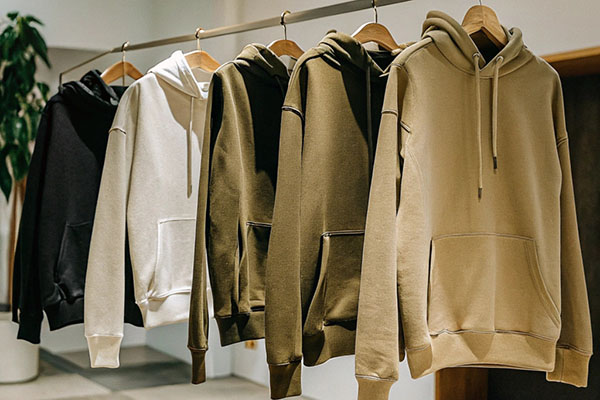Hoodies are a wardrobe staple, loved for their versatility and comfort. But the material used in their construction can significantly impact their quality, durability, and purpose. Whether you’re seeking a hoodie for lounging, workouts, or style, knowing the fabric options can help you make the best choice.
Hoodies are made from various materials, including cotton1, polyester2, fleece3, and blends. Each material offers unique properties, catering to different needs like warmth, breathability, or durability.
Let’s explore the different types of hoodie materials, their benefits, and how to choose the right one for your lifestyle.

What is the best material for hoodies?
The best material for hoodies depends on how you plan to use them. Factors like comfort, warmth, and durability play a significant role in determining the ideal fabric.
Cotton, polyester, and fleece are among the most popular materials for hoodies. Cotton is breathable and soft, while polyester adds durability, and fleece provides warmth. Blended fabrics often combine the best properties of these materials.

1. Cotton: The classic choice
Cotton1 is one of the most common materials for hoodies due to its natural softness and breathability. It’s comfortable for casual wear and works well in mild climates.
Benefits of cotton hoodies:
- Breathable: Allows air circulation, preventing overheating.
- Soft and comfortable: Feels great against the skin, ideal for everyday wear.
- Hypoallergenic: Suitable for people with sensitive skin.
| Property | Benefit |
|---|---|
| Absorbent | Great for absorbing sweat. |
| Lightweight | Ideal for layering or mild weather. |
| Natural fiber | Biodegradable and eco-friendly. |
Pro Tip: Look for 100% cotton hoodies for the softest feel, or organic cotton for a more sustainable option.
2. Polyester: Durable and lightweight
Polyester2 is a synthetic fabric known for its durability and moisture-wicking properties. It’s often used in sports hoodies or blended with other materials to add strength.
Benefits of polyester hoodies:
- Wrinkle-resistant: Maintains shape even after multiple washes.
- Quick-drying: Wicks away moisture, making it ideal for activewear.
- Durable: Resistant to shrinking and stretching.
| Property | Benefit |
|---|---|
| Lightweight | Comfortable for workouts or layering. |
| Resilient | Long-lasting and easy to care for. |
Pro Tip: While polyester hoodies are practical, they may lack the softness of natural fibers. Blended fabrics can offer a balance of comfort and durability.

3. Fleece: Ultimate warmth and coziness
Fleece3 is a synthetic material made from polyester, often used in hoodies designed for colder weather. Its fluffy texture mimics the warmth of wool while remaining lightweight.
Benefits of fleece hoodies:
- Warmth: Retains heat, perfect for winter or outdoor activities.
- Lightweight: Provides insulation without feeling bulky.
- Moisture-resistant: Dries quickly if exposed to rain or snow.
| Property | Benefit |
|---|---|
| Insulating | Traps body heat for maximum warmth. |
| Soft and plush | Feels luxurious and cozy. |
Pro Tip: Look for hoodies with a fleece lining for added warmth during winter months.
4. Blended fabrics: The best of both worlds
Blended fabrics combine natural and synthetic fibers, offering a mix of softness, durability, and performance. Common blends include cotton-polyester and cotton-fleece.
Benefits of blended hoodies:
- Balanced properties: Combines the softness of cotton with the durability of polyester.
- Versatile: Suitable for both casual and active use.
- Cost-effective: Offers better value without compromising on quality.
| Blend Type | Features |
|---|---|
| Cotton-Polyester | Soft, breathable, and wrinkle-resistant. |
| Cotton-Fleece | Warm yet lightweight. |
Pro Tip: For everyday wear, a 50/50 cotton-polyester blend offers the perfect balance of comfort and durability.
5. Wool: Natural insulation
Wool hoodies are less common but prized for their natural warmth and moisture-wicking properties. They are perfect for outdoor enthusiasts or those looking for sustainable options.
Benefits of wool hoodies:
- Warmth: Excellent insulation, even in wet conditions.
- Odor-resistant: Naturally resists odors, ideal for extended wear.
- Sustainable: Biodegradable and renewable resource.
| Property | Benefit |
|---|---|
| Natural fiber | Eco-friendly and breathable. |
| Long-lasting | Durable with proper care. |
Pro Tip: Merino wool4 hoodies are softer and less itchy than traditional wool, making them more comfortable for everyday use.
6. Specialty materials: Bamboo and hemp
Bamboo5 and hemp6 are eco-friendly materials gaining popularity in hoodie production. They offer unique benefits, such as natural antibacterial properties and environmental sustainability.
Benefits of bamboo hoodies:
- Softness: Feels similar to silk or cashmere.
- Antibacterial: Reduces odor buildup.
- Eco-friendly: Requires fewer resources to grow than cotton.
Benefits of hemp hoodies:
- Durability: Stronger than cotton and lasts longer.
- Breathable: Keeps you cool in summer and warm in winter.
- Sustainable: Grown without pesticides and minimal water use.
| Specialty Material | Key Features |
|---|---|
| Bamboo | Luxuriously soft and breathable. |
| Hemp | Durable and eco-conscious. |
How to choose the best hoodie material for your needs?
The best hoodie material depends on your intended use and personal preferences. Here’s how to select the perfect fabric:

1. For casual everyday wear:
- Cotton or cotton blends: These provide softness and breathability, ideal for daily use.
2. For workouts and activewear:
- Polyester or blends with spandex: These materials offer stretch, durability, and moisture-wicking properties.
3. For colder weather:
- Fleece or wool: Opt for these materials for maximum warmth and insulation.
4. For sustainable fashion:
- Organic cotton, bamboo, or hemp: Eco-friendly options that minimize environmental impact.
Care tips for different hoodie materials
Proper care can extend the life of your hoodie and maintain its quality. Here are some tips based on fabric type:
| Material | Care Instructions |
|---|---|
| Cotton | Wash in cold water to prevent shrinking. |
| Polyester | Use gentle cycles to avoid pilling. |
| Fleece | Avoid high heat when drying to maintain texture. |
| Wool | Hand wash or use a wool-specific detergent. |
| Bamboo/Hemp | Wash in cold water and line dry to prevent damage. |
Conclusion
Hoodies are made from a variety of materials, each offering unique benefits. Cotton is breathable and soft, polyester is durable and quick-drying, fleece provides exceptional warmth, and blends balance comfort with functionality. For those seeking eco-friendly options, bamboo and hemp offer sustainability with style. By understanding the characteristics of these materials, you can choose the perfect hoodie to suit your needs, whether for lounging, exercising, or braving the cold.













